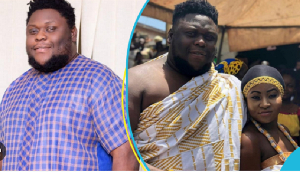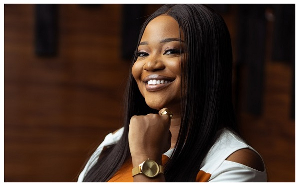Health News of Saturday, 26 May 2007
Source: GNA Feature by Linda Asante Aggyei
Leukemia, cancer of the blood gaining roots in Ghana
Accra, May 25, GNA- "What greater gift can one human being give to another than the gift of life. I am of African decent. You can save my life. Your generosity as a bone marrow or stem cell donor could help me win this battle with leukaemia."
This was the humble request of the late Danny Wyhte, founder of Danny Whyte and the Ivor Burford Leukaemia Trust (DWIB) kept on making during his crusade against cancer.
Cancer (in any form), which was in the days gone by not common and associated with the elderly and affluent in society, has in this modern age become the disease for the young. Many young people of today, who are supposed to be the future leaders of their nations, are now being diagnosed with various types of cancers - breast; lungs; cervica;, stomach; throat and latterly leukemia.
Some years ago in Ghana, this disease was not known but now it is gradually becoming a household name as the days pass by. At least in Ghana, three prominent people have lost their lives to this deadly disease within a year. There are many other leukemia patients under going chemotherapy treatment at the Korle Bu Teaching Hospital and that testifies that it is gaining roots in the Ghanaian society. Susana Ampaw, a second year student of the University of Ghana and the former Chief Justice Charles Acquah died of cancer of the blood and then Danny Whyte.
Leukemia is a form of cancer that begins in the blood-forming cells of the bone marrow - the soft, inner part of the bones. Leukeamia - which literally means "white blood" in Greek - occurs when there is an excess of abnormal white blood cells in the blood. Known as leukocytes, these cells are so plentiful in some individuals that the blood actually has a whitish tinge.
The types of leukemia are grouped by how quickly the disease develops and gets worse. Leukemia is either chronic (gets worse slowly) or acute (gets worse quickly).
With Chronic leukemia, the abnormal blood cells can still do their work in their early stages and people with chronic leukemia may not have any symptoms. Slowly, chronic leukemia gets worse. It causes symptoms as the number of leukemia cells in the blood rises.
With Acute leukemia, the blood cells are very abnormal. They cannot carry out their normal work. The number of abnormal cells increases rapidly and acute leukemia worsens quickly.
The four common types of leukemia are chronic lymphocytic leukemia, which accounts for about 7,000 new cases of leukemia each year. Most often, people diagnosed with the disease are over age 55. It almost never affects children.
Chronic myeloid leukemia, also known as chronic myelogenous leukemia, (CML) accounts for about 4,400 new cases of leukemia each year. It affects mainly adults.
Acute lymphocytic leukemia (acute lymphoblastic leukemia, ALL) accounts for about 3,800 new cases of leukemia each year. It is the most common type of leukemia in young children. It also affects adults. Acute myeloid leukemia, (acute myelogenous leukemia AML) accounts for about 10,600 new cases of leukemia each year. It occurs in both adults and children.
Just like all blood cells, leukemia cells travel through the body depending on the number of abnormal cells and where these cells collect, patients with leukemia may have a number of symptoms. The common symptoms of leukemia includes fevers or night sweats; frequent infections; feeling weak or tired; headache; bleeding and bruising easily (bleeding gums, purplish patches in the skin, or tiny red spots under the skin), pain in the bones or joints, swelling or discomfort in the abdomen (from an enlarged spleen), swollen lymph nodes, especially in the neck or armpit and weight loss..
Such symptoms are not sure signs of leukemia. An infection or another problem also could cause these symptoms. Anyone with these symptoms should see a doctor as soon as possible. Only a doctor can diagnose and treat the problem.
In the early stages of chronic leukemia, the leukemia cells function almost normally. Symptoms may not appear for a long time. Doctors often find chronic leukemia during a routine checkup before there are any symptoms. Symptoms are generally mild at the first stage and it worsens gradually.
In acute leukemia, symptoms appear and get worse quickly. People with this disease go to their doctor because they feel sick. Other symptoms of acute leukemia are vomiting; confusion; loss of muscle control and seizures. Leukemia cells can also collect in the testicles and cause swelling whilst some patients develop sores in the eyes or on the skin. Leukemia also can affect the digestive tract; kidneys; lungs or other parts of the body. These go to show the seriousness and the devastating nature of the disease
Because cancer treatment may damage healthy cells and tissues, unwanted side effects are common and specific side effects depend on many factors, which include the type and extent of the treatment. Side effects vary from person to person and they may even change from one treatment session to the next.
The side effects of chemotherapy depend mainly on the specific drugs and the dose. In general, anticancer drugs affect cells that divide rapidly, especially leukemia cells. Chemotherapy can also affect other rapidly dividing cells.
The blood cells fight infection, help the blood to clot, and carry oxygen to all parts of the body. When blood cells are affected, patients are more likely to get infections, may bruise or bleed easily, and may feel very weak and tired.
With the cells in hair roots, chemotherapy could lead to hair loss and when the hair grows back, the new hair may be somewhat different in colour and texture. For the cells that line the digestive tract, chemotherapy could cause mouth and lip sores, nausea and vomiting, diarrhea, and poor appetite. Many of these side effects could be controlled with drugs but these anti cancer drugs can affect a patient's fertility. Whilst women may have irregular menstrual periods or periods may stop altogether they may also have symptoms of menopause, such as hot flashes and vaginal dryness. For the men, they may stop producing sperm. Because these changes may be permanent, some men have their sperm frozen and stored before treatment. Most children treated for leukemia appear to have normal fertility when they grow up. However, depending on the drugs and doses used coupled with the age of the patient, some boys and girls may be infertile when they mature. The side effects of biological therapy differ with the types of substances used, and from patient to patient. Rashes or swelling where the biological therapy is injected are common. Flu-like symptoms may also occur and the health care team may monitor the blood for signs of anemia and other problems.
The radiation therapy may cause patients to become very tired as treatment continues and in this case, resting is important, but if chemotherapy is given at the same time, the side effects may be worse. Patients who have stem cell transplantation face an increased risk of infection, bleeding, and other side effects because of the large doses of chemotherapy and radiation they receive. In addition, Graft-Versus-Host Disease (GVHD) may occur in patients who receive stem cells from a donor's bone marrow.
In GVHD, the donated stem cells react against the patient's tissues. Most often, the liver, skin, or digestive tract is affected. GVHD can be mild or very severe. It can occur at any time after the transplant and even years after. Steroids or other drugs may help.
Danny Whyte was diagnosed with Leukaemia in April 2004 and underwent four courses of chemotherapy treatment, over an eight-month period. He was given the all clear at the end of January 2005. He had a relapse on 29th June 2005 and had to be admitted again for another five months. During one of his routine check ups on the 5th of Feb 2007 he was informed that he had relapsed again and was re-admitted and underwent another course of chemotherapy. This time, He needed a bone marrow transplant, which was his only chance of a cure.
"For a match to be found for me, I need people like you to act now and get tested. I have just a 1 in 100,000+ chance of finding a match because I am of African decent. You can save my life. Your generosity as a bone marrow or stem cell donor could help me win this battle with leukemia" he said when he launched the crusade for the cure not only for him but other patients.
Tissue type is ethno-geographically determined, inherited like eye or hair colour. A patient's best chance of finding a genetic match lies with those of similar ethnic ancestry.
Though a blood stem cell transplant is Danny's last hope, none of the potential donors on the worldwide register was an appropriate match for him.
Danny, who was the Chief Executive Officer of the Osu-based Information Technology firm called Whytsys, was forced by the disease to return to live in the UK where he could get treatment. He returned to Ghana to search for such a match, and launched a new bone marrow register - the first of its kind in black Africa. The only other register in Africa, which lists potential donors who may be called upon to provide life-saving blood stem cells to leukemia patients is based in South Africa and consists almost entirely of white donors. In January 2005 Danny set up the DWIB Leukemia Trust (Ghana), along with Ivor Burford, a Jamaican former leukemia patient, with the aim of increasing awareness of leukemia in the West African Sub-Region and created access to effective diagnostic and treatment resources as well as setting up the first bone marrow register in West Africa. The results of this preliminary blood test will then be stored on a database, before, if a match is found, registered participants may be asked, weeks, months or even years later, to undergo more detailed tests and/or to donate blood stem cells, which are found in the circulating blood stream.
Bone marrow is found in the centre of all large bones and is where primitive blood cells, known as blood stem cells, are produced. These cells can be collected via a sustained needle on a blood cell separator machine, in a painless process which takes 3-4 hours.
Only a complete 'match' can be used, however - and the chances of a black or mixed-race leukemia patient finding a donor are currently only about 1 in 100,000; compared to a 1 in 3 or 1 in 4 chance of a white leukemia patient finding an exact bone marrow match.
This is because so few blacks are registered, and because tissue type is ethno-geographically determined, inherited like eye or hair colour, as Danny explained: Only Africans can donate to Africans, and the problem for Danny was that very few people of African origin have ever registered as potential bone marrow donors.
Of the 10 million potential bone marrow donors worldwide, 9.3 million of these were of European origin. The other 700,000 were the combined number of black, Asian and mixed-race potential donors. The response was overwhelming and gave people who donated the chance to know more about it, and the experiences of these people helped to "de-mystify" the issue and prompted more people to respond. Worldwide, 100,000 babies are born with the disease annually. Those born in developing countries are unlikely to survive for long. Bone marrow transplantation can provide a cure for sickle cell anemia, but the risks are so great that doctors have wa that it is only an option for the severely ill.
Danny Whyte is dead just when a match was found. There are many other people out there just like Danny but who are very poor and cannot afford the cost of treatment. Let us all put our efforts together to continue the good works Danny and start to save the lives of leukemia patients.
May the soul of Danny Whyte rest in perfect peace. 25 May 07










